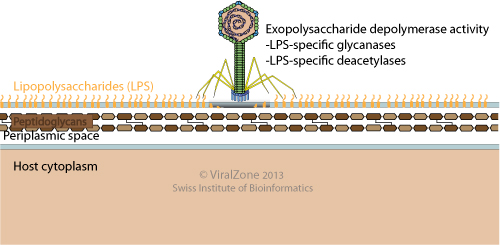Some bacterial viruses carry an enzymatic activity to degrade the lipopolysaccharides (LPS) of Gram-negative bacteria. This activity is often associated with the tailspike proteins. LPS degradation may be utilized by the bacteriophage to clear a path through the bacterial LPS to gain access to the entry receptor on the cell surface. Interestingly, LPS degrading viruses can also use LPS as attachment receptor. In that case an alternative theory is that LPS degradation may act to release progeny phage particles from cellular debris at the end of a lytic cycle.

| Virus | Family | Host bacteria | Surface component type | Phage degrading enzyme | Ref. |
| Phage HK620 | Podoviridae | Escherichia coli H | LPS | Tail spike endo-N-acetylglucosaminidase |  |
| Phage P27 | Unclassified | Salmonella typhimurium | LPS | Endorhamnosidase |  |
| Phage 9NA | Unclassified | Salmonella typhimurium | LPS | Endorhamnosidase |  |
| Phage KB-1 | Unclassified | Salmonella typhimurium | LPS | Endorhamnosidase |  |
| Phage Det7 | Myoviridae | Salmonella typhimurium | LPS | Endorhamnosidase |  |
| Phage P22 | Podoviridae | Salmonella typhimurium | LPS | Endorhamnosidase |  |
| Phage Sf6 | Podoviridae | Shigella flexneri | LPS | Endorhamnosidase |  |
| Phage & epsilon 15 | Podoviridae | LPS | Endorhamnosidase |  |

